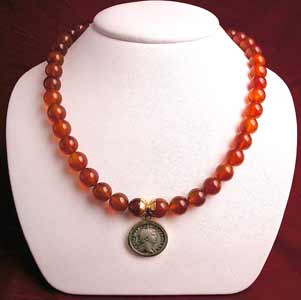Carnelian Beaded Necklace Featuring a Roman Silver Denarius of Emperor Trajan, 98 CE - 117 CE
Silver and Carnelian
FJ.5149
Further images
This genuine Ancient Roman coin has been set in a modern 18 karat gold pendant and strung on a necklace composed of genuine carnelian beads with an 18 karat gold...
This genuine Ancient Roman coin has been set in a modern 18 karat gold pendant and strung on a necklace composed of genuine carnelian beads with an 18 karat gold clasp.
C. Messius Quintus Trianus Decius was born about 201 A.D. In lower Pannonia (now Hungary and Yugoslavia). He was governor of lower Moesia (southern Europe) from 234-238 A.D. Following the abortive rebellion of upper Moesia, Philip dispatched Decius to restore order; but the rebels forced the latter, under threat of death, to "assume the purple" and march upon Italy. In the ensuing battle Philip and his son were slain and Decius w as left undisputed master of the empire. Much of his short reign was spent in fighting the barbarians on the northern frontier and in a battle against the Goths in 251 A.D. Decius was defeated and killed. Unfortunately, the reign of Decius is best known for his rigorous persecution of the Christians, in which pope Fabian lost his life. Apart from Decius' own coins, and those of his wife and sons, he also struck a series of coins commemorating most of the deified emperors from Augustus to Severus Alexander.
The ancient Egyptians believed that fiery orange-red carnelian was the distilled essence of the Sun's rays, and many of the jewels of the Pharaohs were carved from it. The name of this generally translucent variety of chalcedony comes from the Latin word for flesh, for that is what its warm reddish tones reminded the Romans of. Since earliest times, carnelian has been prized for its rich, radiant color like the heart of a glowing fire. Carnelian jewels have been discovered in the Royal tombs of Ur, Egypt and the Holy Land. One royal lady of ancient Jordan was found buried with a carnelian and gold necklace over ten feet in length. The Prophet Mohammed himself is said to have worn a ring set with this gem. As an amulet, carnelian is favored to act on the blood, preventing it from rising in excess to the head, stopping nosebleed, easing menstrual flow and causing blood to circulate smoothly throughout the body. It is believed to make the skin healthy and youthful, removing sores and blemishes when worn. Because of its calming effects on the blood, carnelian also makes one feel peaceful and slow to anger. It is theorized that the color orange is the harmonious balance of passionate, creative red and bright, cheerful yellow, which makes it particularly soothing to wear. Carnelian is the perfect stone to achieve that blissful state of balance.
C. Messius Quintus Trianus Decius was born about 201 A.D. In lower Pannonia (now Hungary and Yugoslavia). He was governor of lower Moesia (southern Europe) from 234-238 A.D. Following the abortive rebellion of upper Moesia, Philip dispatched Decius to restore order; but the rebels forced the latter, under threat of death, to "assume the purple" and march upon Italy. In the ensuing battle Philip and his son were slain and Decius w as left undisputed master of the empire. Much of his short reign was spent in fighting the barbarians on the northern frontier and in a battle against the Goths in 251 A.D. Decius was defeated and killed. Unfortunately, the reign of Decius is best known for his rigorous persecution of the Christians, in which pope Fabian lost his life. Apart from Decius' own coins, and those of his wife and sons, he also struck a series of coins commemorating most of the deified emperors from Augustus to Severus Alexander.
The ancient Egyptians believed that fiery orange-red carnelian was the distilled essence of the Sun's rays, and many of the jewels of the Pharaohs were carved from it. The name of this generally translucent variety of chalcedony comes from the Latin word for flesh, for that is what its warm reddish tones reminded the Romans of. Since earliest times, carnelian has been prized for its rich, radiant color like the heart of a glowing fire. Carnelian jewels have been discovered in the Royal tombs of Ur, Egypt and the Holy Land. One royal lady of ancient Jordan was found buried with a carnelian and gold necklace over ten feet in length. The Prophet Mohammed himself is said to have worn a ring set with this gem. As an amulet, carnelian is favored to act on the blood, preventing it from rising in excess to the head, stopping nosebleed, easing menstrual flow and causing blood to circulate smoothly throughout the body. It is believed to make the skin healthy and youthful, removing sores and blemishes when worn. Because of its calming effects on the blood, carnelian also makes one feel peaceful and slow to anger. It is theorized that the color orange is the harmonious balance of passionate, creative red and bright, cheerful yellow, which makes it particularly soothing to wear. Carnelian is the perfect stone to achieve that blissful state of balance.





